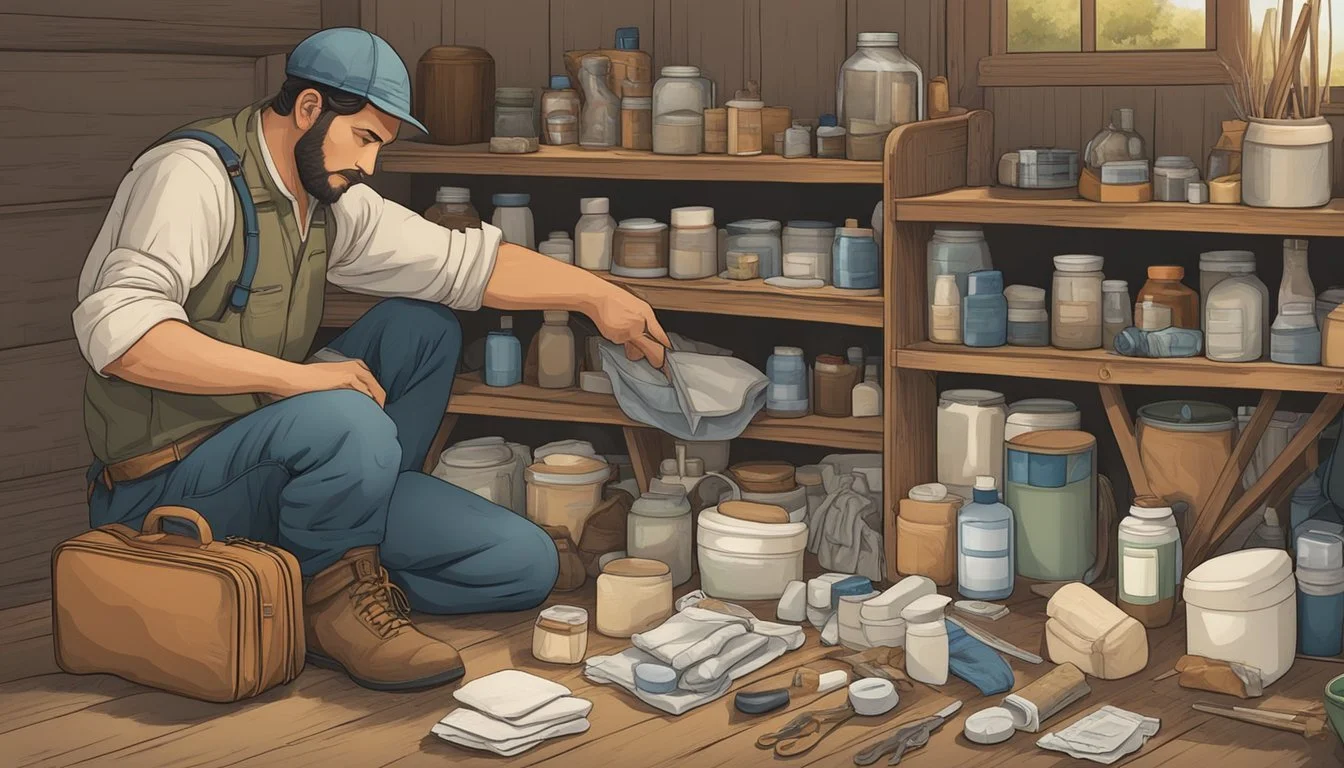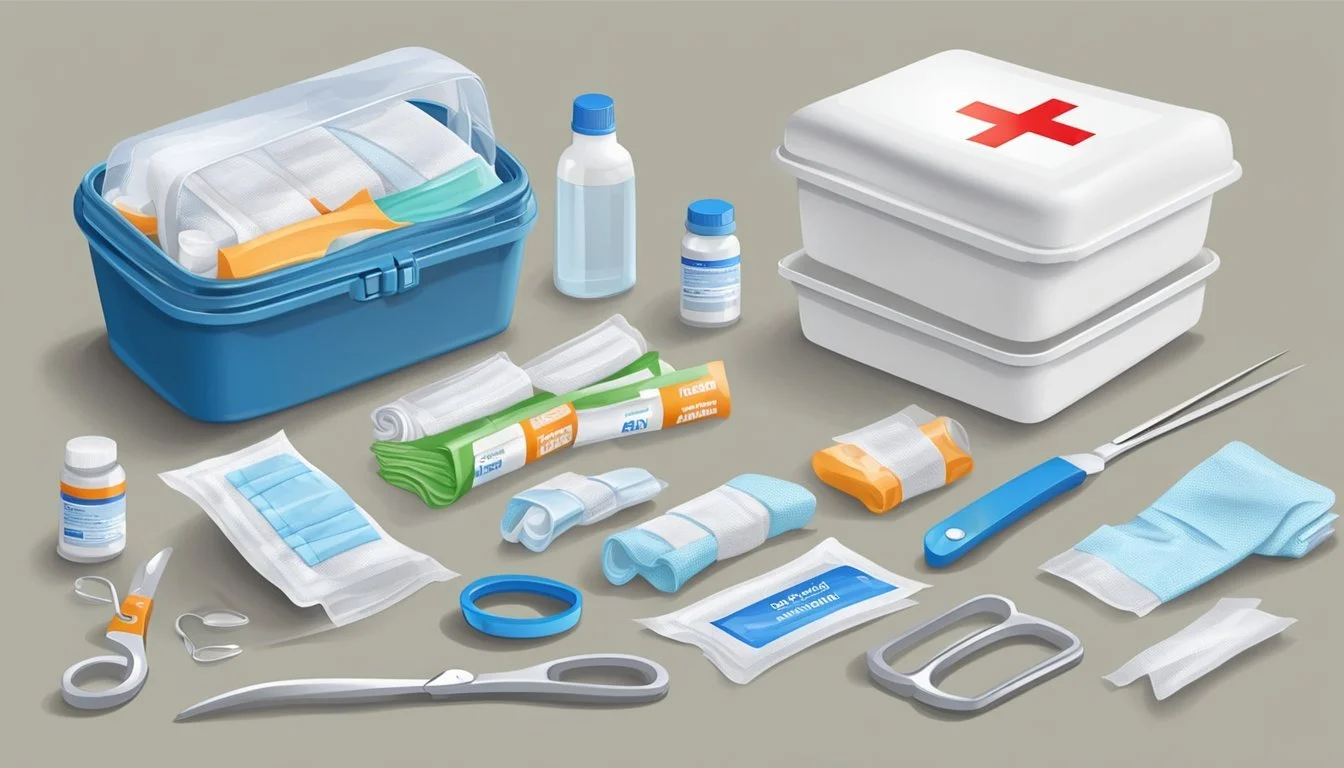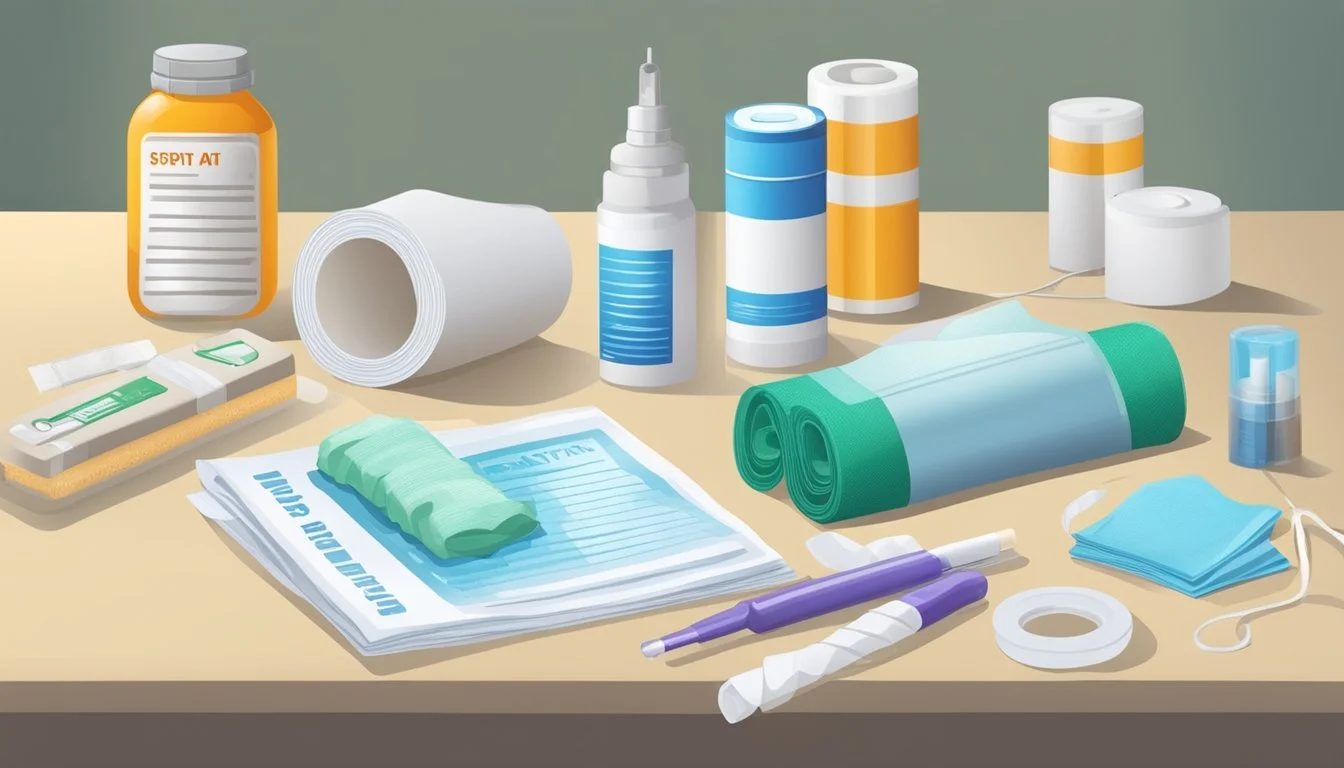Essential Homesteading First Aid Kit
Your Guide to Managing Minor Injuries
A comprehensive first aid kit is an indispensable element for any homesteader. Given the nature of homesteading, which often involves a combination of agriculture, manual labor, and machinery use, the potential for minor injuries is higher than in less hands-on environments. The ability to swiftly and efficiently address cuts, scrapes, burns, and other minor injuries not only ensures the well-being of those on the homestead but also contributes to the uninterrupted flow of daily activities.
A well-stocked first aid kit on a homestead should contain items tailored to the specific needs of the environment. It will likely include various sizes of adhesive bandages, sterile gauze pads, and antiseptic wipes or creams to prevent infection. Equipment for immobilizing injuries like sprains or fractures, such as elastic bandages or splints, may also be essential. Moreover, items such as tweezers for splinter removal, scissors for cutting bandages or clothing, and gloves for hygiene are crucial.
In preparing for emergencies, homesteaders recognize the value of being self-reliant, thus, they engage in first aid training to use these tools effectively. Knowledge in CPR and wound care becomes part of their skill set, allowing for competent responses to various situations. The readiness to manage minor injuries with the right materials and know-how exemplifies the homesteader's commitment to safety and self-sufficiency.
Understanding the Basics
A well-equipped first aid kit is vital for prompt and efficient response to accidents on a homestead. It ensures that minor injuries can be treated immediately, reducing the risk of complications and promoting a safe environment for family members.
What Constitutes a First Aid Kit
The core components of a first aid kit for a homestead include items specifically designed to manage minor emergencies and injuries. This kit should contain:
Bandages and Gauze: Various sizes for covering wounds.
Antiseptics: Wipes or sprays to sanitize injuries.
Pain Relievers: Such as paracetamol or ibuprofen for managing pain.
CPR Supplies: Face shield or mask for barrier protection during resuscitation.
Protective Gloves: To maintain hygiene and protect against infection.
These items combined can address common first aid needs such as cuts, scrapes, and burns.
First Aid Principles for Homesteaders
Homesteaders should adopt first aid principles that go beyond the physical items in their kit. These principles include:
Knowledge and Training: Understanding how to use each item in the first aid kit is crucial. Taking courses from recognized organizations like the American Red Cross can be beneficial.
Quick Response: An emergency requires immediate action to keep it from escalating.
Peace and Calm: Maintaining a sense of peace and quiet during an incident helps reduce panic and allows one to administer aid effectively.
Local Emergency Contacts: Always have a list of emergency numbers readily accessible.
Adherence to these principles ensures that homesteaders are prepared not just with tools, but with the competence and presence of mind required to handle first aid situations.
Preparation and Prevention
Properly preparing for emergencies involves more than just assembling a first aid kit; it requires training and the establishment of preventive practices. A well-thought-out approach helps ensure that homesteaders are equipped to handle common injuries with efficacy and confidence.
Assembling Your First Aid Kit
A first aid kit is a fundamental component of homestead preparedness. The kit should include:
Essential Supplies:
Adhesive bandages of various sizes
Sterile gauze and tape
Antiseptic wipes and creams
Tweezers and safety pins
Scissors and an ankle brace
Activated charcoal for poisoning
Ice packs for reducing swelling
Medications:
Pain relievers like acetaminophen or ibuprofen
Allergy medications such as antihistamines
Documentation:
A comprehensive first aid manual
A list of emergency phone numbers
Training and Knowledge
Homesteaders must educate themselves on basic first aid and CPR techniques; this is as vital as the first aid kit itself. They should enroll in certification courses provided by reputable organizations like the American Red Cross. Practical knowledge in treating burns, controlling bleeding, and recognizing signs of serious health issues can be the difference between a minor incident and a severe one.
Preventive Practices on the Homestead
Prevention is key to minimizing the risk of injuries. Homesteaders should:
Conduct regular safety checks on equipment and structures
Keep living and working areas clean to prevent falls and other accidents
Store tools and chemicals securely and out of reach of children
By implementing these strategies, homesteaders proactively reduce the likelihood of accidents and injuries, maintaining a safer environment for themselves and their families.
Kit Essentials
A well-stocked first aid kit is crucial for any homestead, providing the tools and medications necessary to promptly address minor injuries.
Basic Supplies and Equipment
Every first aid kit should include gloves to maintain hygiene and scissors for cutting bandages or clothing. Sterile gauze pads and a variety of bandages are necessary for dressing wounds. It's important to have antiseptic wipes to clean the injured area and a thermometer to check for fever.
Gloves: Essential for infection control.
Scissors: For cutting materials to size.
Gauze Pads: In various sizes for wound dressing.
Bandages: Assorted sizes, including adhesive and wrap bandages.
Antiseptic Wipes: To sanitize wounds or skin before bandaging.
Thermometer: To monitor potential fevers.
Medications to Include
Include basic over-the-counter pain relievers such as ibuprofen or acetaminophen to manage discomfort. An antibiotic ointment is crucial to prevent infection in cuts and scrapes.
Pain Relievers: Ibuprofen or acetaminophen for pain and fever.
Antibiotic Ointment: To prevent bacterial infections in minor wounds.
Supplies for Common Injuries
A homestead first aid kit should be stocked to handle common injuries such as burns, cuts, and sprains. Include burn cream and hydrocortisone for insect bites or rashes.
Burn Cream: For minor burn treatment.
Hydrocortisone Cream: To alleviate itching and rashes.
Specialized Items for Homesteading
Homesteaders might encounter unique challenges that require specialized first aid items. For example, splints for potential fractures and a snake bite kit in areas with venomous snakes.
Splints: For immobilizing possible fractures.
Snake Bite Kit: Essential in regions with venomous snakes, it can be pivotal while awaiting medical care.
Handling Specific Injuries
When tending to injuries on a homestead, it's important to know the correct procedures and have the appropriate supplies at hand. Whether it’s dealing with a simple cut or a more complex injury like a burn, quick and efficient treatment can prevent further complications.
Cuts, Scrapes, and Puncture Wounds
Cuts, scrapes, and puncture wounds are common injuries that require immediate attention. First, one should clean the wound with water and mild soap to prevent infection. Use antiseptic to disinfect, and then cover with a sterile bandage or gauze. For deeper wounds or those that won't stop bleeding, apply pressure and elevate the area, seeking medical attention if necessary.
Sprains, Strains, and Broken Bones
For sprains and strains, follow the R.I.C.E method – Rest, Ice, Compression, and Elevation. An ankle brace or elastic bandage can provide support. In case of a suspected broken bone, one should immobilize the area with a splint and seek medical attention immediately. Avoid moving the injured person unless absolutely necessary.
Burns and Sunburn
For minor burns, run cool water over the area and then cover it with a clean dressing. Do not apply ice or butter, as it can cause further damage. For sunburns, aloe vera gel or moisturizing lotion can provide relief. In the case of severe burns, covering them with a sterile, non-adhesive bandage and seeking professional medical help is crucial.
Bites and Stings
First, remove any stingers with a flat-edged object like a credit card to avoid squeezing more venom into the wound. Clean the area and apply ice to reduce swelling. If the bite is from a known venomous animal or if an allergic reaction occurs, seek emergency medical aid. Keep an epinephrine auto-injector (if prescribed) accessible for those with serious allergies.
Eye Injuries and Contamination
If foreign substances enter the eye, one should gently rinse the eye with clean water or saline solution. If an object is stuck in the eye, do not attempt to remove it — cover the eye with a paper cup and secure it before getting medical help. For chemical exposure, rinse the eyes immediately and continuously for at least 15 minutes, while seeking emergency care.
Managing Emergencies
In addressing emergencies on a homestead, the primary concern is to stabilize the injured party and control the situation. Swift and precise action can prevent minor injuries from escalating and ensure that any major concerns are quickly attended to by medical professionals.
Immediate Care Protocols
When an emergency arises, immediate care protocols focus on assessing the situation and providing prompt support. For bleeding, one should apply firm pressure with a clean cloth to the wound. If available, wearing gloves is advisable to reduce the risk of infection. In cases of shock or when attempting to preserve body heat, an emergency blanket should be used. This item reflects back the body's warmth and is a vital component in managing the body temperature of an injured individual.
For minor injuries, such as cuts and scrapes, thorough cleaning with water, followed by disinfection with antiseptics, is crucial. The application of bandages or sterile dressings helps protect the wound from further contamination.
When to Seek Professional Help
Immediate transportation to a hospital is imperative when an injury results in uncontrolled bleeding, loss of consciousness, or severe pain that could indicate broken bones or internal injuries. Signs of infection, such as redness, swelling, or fever, also warrant a visit to a healthcare provider. It's crucial to recognize when home remedies are insufficient and professional medical assistance is needed to prevent complications, such as severe blood loss or death. Homesteaders should always have emergency numbers on hand and a strategy for reaching a hospital swiftly in a time of need.
Addressing Environmental Challenges
When homesteading, individuals may face environmental challenges that can have a significant impact on health and safety. Preparation and proper first aid resources can mitigate the risks associated with extreme temperatures and natural toxins.
Frostbite and Hypothermia
Frostbite occurs when skin and other tissues freeze due to exposure to cold weather. It most commonly affects the extremities such as the fingers, toes, ears, and nose. The first aid kit should include:
Thermal blankets to retain body heat
Instant heat packs to warm affected areas indirectly (never apply directly to the skin)
Hypothermia results from the body losing heat faster than it can produce it, causing core body temperature to drop. Key first aid supplies include:
Dry clothing to replace any wet garments
Insulated gloves and hats
A bivy sack or emergency shelter for protection against the wind and cold
Heat Exhaustion and Heat Stroke
Heat exhaustion is a condition resulting from exposure to high temperatures, often accompanied by dehydration. Symptoms include heavy sweating and a rapid pulse. Homestead first aid kits should be equipped with:
Electrolyte tablets or solutions to replenish lost salts
Fans or battery-operated handheld fans to promote cooling
A misting bottle to help lower body temperature
Heat stroke is more severe and occurs when the body temperature reaches 104°F (40°C) or higher. Immediate action is required and can include:
Evaporative cooling techniques using lukewarm water (not cold, as it can cause shock)
Space blankets to shade and protect from direct sunlight
Informative cards with the signs of heat stroke and instructions for immediate response
Dealing with Natural Toxins
Exposure to toxic plants can result in skin irritation or more serious poisoning. A well-prepared first aid kit includes tools to handle these situations:
Calamine lotion and hydrocortisone cream for skin irritations
Activated charcoal in case of ingestion of toxins, after contacting Poison Control
A booklet with pictures and descriptions of local toxic plants and their first aid procedures
Providing clear and concise information on how to recognize and treat environmental health threats will ensure that homesteaders are ready to respond effectively, maintaining the safety and well-being of all residents.
Homestead-Specific Considerations
Creating a first aid kit for a homestead requires bearing in mind the unique challenges and hazards associated with rural living. From injuries related to animals and machinery to the necessities of managing remote medical issues, each aspect demands thoughtful preparation.
Injuries from Animals and Machinery
Homesteaders regularly interact with animals and operate heavy machinery, increasing the risk of injury. A well-stocked first aid kit should include:
Bandages and antiseptics for cuts or scrapes from wire fences or animal claws.
Splints and wraps to support strains or sprains caused by handling large animals or operating equipment.
Ensuring the availability of heavy-duty gloves can also mitigate the risk of hand injuries.
Preparing for Remote Medical Issues
Living remotely on a homestead often means medical help is not immediately accessible. It's critical to include:
Communication devices such as a satellite phone to contact emergency services.
Comprehensive guides on first aid procedures.
Extended medication supplies considering the potential wait time for medical assistance.
A homestead first aid kit might also incorporate items designed for extended self-reliance, like suturing kits, under the guidance of a medical professional.
Ensuring Safety during Butchering and Food Processing
Butchering meat is a requisite task on many homesteads and poses its own set of risks. For this, a first aid kit should be equipped with:
Cut-resistant gloves to protect hands from knives and other sharp tools.
Eyewash to quickly cleanse any contaminants from the eyes.
Burn care supplies for treating accidental burns from processing equipment.
Carrying a personal protective gear like aprons and goggles further enhances safety during these tasks.
Advanced First Aid
In the realm of homesteading, advanced first aid skills can be crucial when addressing severe injuries. This section will focus on life-saving techniques like using tourniquets and hemostatic agents, as well as stabilization methods necessary before transporting an individual to a medical facility.
Utilizing Tourniquets and Hemostatic Agents
Tourniquets are a critical component for controlling life-threatening bleeding from extremities. They come into play when pressure and bandaging are insufficient to stop the hemorrhage. Here's a brief guide on using a tourniquet:
Apply the tourniquet above the wound site; if on a limb, place it 2-3 inches above the injury, avoiding joints.
Tighten the tourniquet until the bleeding stops.
Secure the tourniquet and note the time of application.
Hemostatic agents, like gauze impregnated with blood-clotting substances, can also be used for wound packing to control bleeding. These substances accelerate the body's natural clotting process and are particularly useful for injuries not suitable for tourniquet application.
Stabilization Techniques before Transport
Once bleeding is controlled, stabilization becomes the priority to prevent further injury during transport to advanced care. Below are key stabilization techniques:
For suspected neck or back injuries, immobilize the patient using a backboard or improvised devices like a sturdy piece of plywood. Cervical collars can be applied if trained to do so.
When dealing with broken limbs, splints can be fashioned out of materials like boards or stiff cardboard, fastened with rope or belts to the injured limb to keep it immobile.
Administering medications like ibuprofen or acetaminophen can help manage pain and inflammation, but be aware of any allergies that the patient may have. Always follow the recommended dosages and consider possible interactions with other medications the individual may be taking.
Remember, advanced first aid is a bridge to professional medical treatment and should be performed by those with proper knowledge and training.
Children and Elderly Care
When assembling a first-aid kit for a homestead, it's critical to tailor its contents to accommodate the unique needs of children and the elderly. These groups may have different susceptibilities and requirements for care in the event of an injury or illness.
Age-Appropriate Items and Considerations
Children:
Thermometer: A digital thermometer suitable for pediatric use.
Bandages: Various sizes, including smaller bandages tailored for little fingers.
Dosage equipment: Medicine droppers or dosage spoons for accurate administration of liquid medications.
Elderly:
Easy-open bandages: For those with limited dexterity.
Pill cutter: To assist with managing medication that needs to be taken in lower dosages.
Glasses magnifier: To help read small print on medication labels.
Chronic Illnesses and Special Needs
Chronic Illnesses:
Medication list: A comprehensive list of medications, dosages, and schedules for individuals with chronic conditions, such as diabetes or hypertension.
Emergency contacts: A detailed list of healthcare providers and family members who can assist in a crisis.
Special Needs:
Medical Alert Bracelets: Devices that note critical health information for both children and the elderly.
Gait aids: Items such as canes or walkers for the elderly who need assistance with mobility.







